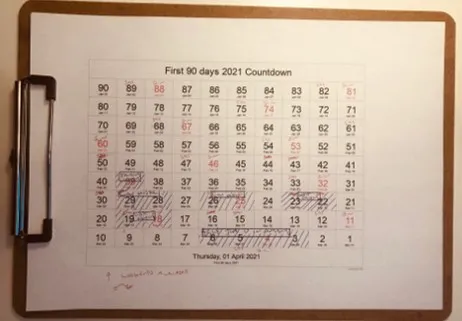Here are eight steps to help you finally achieve your goals.
80% of people who make New Year’s resolutions will have failed them by the second week of February. Research conducted by Strava using 800 million user activities in 2019, found most people had given up on their New Year’s resolutions by January 19. They call this Quitter’s day.
You’re probably all too familiar with the failure statistics of New Year’s resolutions — most likely you are one of them.
The problem with New Year’s resolutions…
Don’t get me wrong, I love setting out my goals for the year. A new year feels like a wide-open space, free of the obligations and obstacles of day-to-day life. This year will be the year I finally achieve my most audacious goals, I tell myself.
The problem is, when you’re making your New Year’s resolutions, you will most likely be relaxed; replete with festive food, having imbibed the holiday spirit (and the wine). The stresses of work are far from your mind, and few of the day-to-day pressures that make these commitments difficult are present.
Setting your goals while on holiday gives you space and mental clarity to hone in on what you want to achieve, but fails to take into account how to make them a reality among the regular demands of life.
Rather than face another year of failure, here are eight simple steps you can take to help you stick to your New Year’s resolutions, and achieve any goal you set.
Step 1: List out your goals, and understand your ‘why.’
Start by allowing yourself to dream a little. I like to segment my life into four areas: family, friends, work, and fitness; then list out everything I want to achieve over the next year.

You want to really get under the skin of each goal, making sure you know not just what you want to achieve but why you want to achieve it. When I took the time to think this through, something interesting happened. I realized my ‘reasons why’ were in fact my goals, and my original goals were actions I could take to achieve them.
Take my friendship goals as an example. One of my goals is to visit a good friend of mine who is moving to Germany for personal reasons. In exploring ‘the why’ I realized my goal is in actual fact, to be a better friend to the people I care about. Visiting my friend is one action I can take to achieve that goal. This realization allowed me to identify additional activities that will help me progress towards my goal of being a better friend.

Finally, assign a deadline to each goal, to make it concrete and timebound, not some lofty ambition that you’ll never get round to.

Step 2: Prioritise your goals.
The next step is to eliminate some goals. The more goals you have, the more they compete with each other for your time, money and attention — resources you cant easily recoup.
One of the fastest ways to make progress is to simply focus on one goal at a time. To do this I split the year into four quarters, then identify which goals I wish to focus on in the first 90 days. It’s ok to have more than one goal, but the fewer you have, the more focus you can give, the more likely you are to achieve them.
Really take time to reflect on this — what are the select activities that you frequently find yourself returning to again and again?
The aim is to focus on a small number of activities, chosen because they support things you deeply value. To borrow from the author Cal Newport: do less, do them better, and know why you’re doing them.
Step 3: Decide what you are willing to pay.
Achieving any goal will take from you. This will either be in the form of the time you need to dedicate to achieving a goal, or money that could be used for other things. Who wouldn’t want to write a New York Times bestseller, make more money or be in better shape?
It’s easy to fantasize about reaching the end goal. But really consider what investment is required to make your goals a reality. Are you willing to go for a run three or four times a week? Sure, you want to write 50 articles in ten weeks on medium. Do you have the time each week to achieve this? Or are you setting yourself up for failure?
Goal setting is not just about choosing the achievements you want to have, but also accepting the price you have to pay. Look back over your goals — are you willing to pay the price?

Step 4: Build systems.
Goals, or New Year’s resolutions, are specific endpoints you want to reach. To make your goals a reality, you need to develop a system, an actionable plan outlining how you will make progress towards your goals.
To give you a couple of examples:
One of my goals is to diversify my career. How? By writing my first 50 articles on medium. My system? I know it takes me 4–5 hours to write a good article, and I can dedicate approximately 18 hours a week — so I am scheduling writing for Friday, Saturday, and Sunday mornings, and editing on a Monday night. 4 articles a week means it’ll take me 12.5 weeks to reach my goal. (It also has a cost, no more lie-ins on weekends).
Another goal is to make exercise a daily habit. How? By finding 30–60 minutes a day to workout. My system? As finding time is my biggest barrier to exercise, I’ve chosen to work out at home to not spend time going back and forth to the gym. So I’ve invested in an exercise bike and some free weights. Each day I schedule an hour in my diary to work-out, no matter what.
Step 5: Engineer your environment.
Achieving new goals requires you to adopt new behaviours (i.e. my daily workout habit). Choice architecture — the proactive design of your environment is a powerful way of ensuring you engage in these new behaviours.
Every behaviour is initiated by a cue, and we are more likely to notice cues that stand out. Unfortunately, the environments we live and work in often make it easy to not do certain activities, because there is no obvious cue to trigger the behaviour. It’s easy to not read a book when your books are hidden away. It’s easy to eat badly when the biscuit (cookies for US readers) jar is on display.
If you need to adopt new behaviours to achieve your goals, make the cue a big part of your environment.
For example, I now leave some weights under my desk and keep books I’m actively reading on the corner of my desk. Previously these have all been neatly stored away, out of sight and out of mind.

Step 6: Create a 90-day plan.
Ambitious, long term goals that make you excited are great. But researchers have found that more immediate goals further increase your ability to stay on track. Develop a 90-day plan, and schedule out not just what actions you need to take, but when you will take them.

Developing a specific plan for when, where and how you will undertake the actions needed to meet your goals will dramatically increase the odds that you will follow through.
Step 7: Find a support group.
Social support is a vital component of achieving any goal. We can see the power of this in public health campaigns such as Dry January and Stoptober, where a large population with the same goal is used to help people feel accountable, commit, and provide encouragement and support.
It can be hard to stay motivated when you feel alone. The good news? You are far from alone, people who share your goals are well within your reach. There are hundreds of writing groups on Facebook. You can post a status update on your social media asking your friends if anyone would like to be your gym or accountability buddy.
Strength in numbers is powerful, so use it to your advantage.
Step 8: Build feedback loops.
The human mind loves to receive feedback. One of the most motivating things we can do is demonstrate to ourselves evidence of progress. By measuring your results you gain insight into whether or not you are making progress.
Schedule a twenty-minute slot on your calendar each week, and take the time to track your progress.
Parting thoughts
I hope you have found these steps useful. They have certainly challenged me to think more critically about what I want to achieve this year. To leave you with some parting thoughts:
· Prioritise your goals: focus on less, do it better and know why
· Your remaining goals should be exciting, high impact, and deeply aligned to your values
· Understand the time and financial price you have to pay to achieve each goal
· Put systems in place: while a goal sets a direction of travel, actions and behaviours are where you will make progress
· Measure your progress: what isn’t measured can’t be improved
And bottom line, resolve to finally do the things that you will be glad to have done when you look back a year from now.





